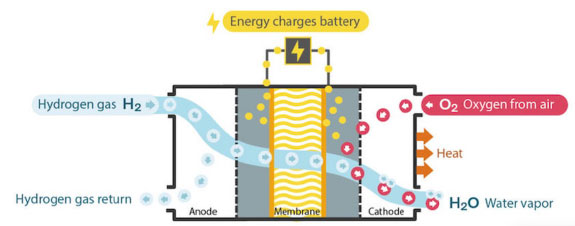As excited as I am about how fast artificial intelligence is advancing, I am extremely concerned that our energy infrastructure won’t be up to the challenge.
By 2030, AI data centers could consume nearly 10% of all the electricity produced in the United States.
Source: Goldman Sachs
That’s more power than every home in California and New York combined.
And we’re feeling the strain already.
In Virginia — the epicenter of America’s data center industry — utilities are warning of multi-year delays to connect new projects. And in Georgia and Texas, regulators are scrambling to approve new natural gas plants just to keep up with the demand.
Even Wall Street is on high alert about this issue. Goldman Sachs estimates that power demand from U.S. data centers will more than double by 2030, driven almost entirely by AI.
Yet our power grid is already stretched to its limits.
And if the grid can’t keep up, then how will America power the next generation of AI?
We’ve talked about how nuclear energy might become the ultimate power source for AI…
And how fusion could provide unlimited energy in the future.
But what if I told you that the Earth’s crust holds a surprising energy source that could supply humanity’s energy needs for the next 170,000 years?
Enter Hydrogen
Clean energy proponents usually focus on solar panels or wind turbines.
But without steady backup, they can leave entire regions vulnerable when demand surges or the weather turns.
These energy sources also take up a lot of land, and communities often push back because they don’t want turbines or solar fields hurting their views or property values.
That’s why a different clean technology has started moving into the spotlight…
Hydrogen fuel cells.
Instead of burning fuel, a hydrogen cell splits molecules to generate electricity.

Image: Volvo Construction Equipment & Services
The only byproduct they create is water, and that can be reused for cooling in data centers.
To be clear, this isn’t a new technology. Hydrogen fuel cells have been a niche source of energy for decades now.
They’ve been used as backup power for telecom towers and in experimental buses in California. They’ve even been used in forklifts in Amazon’s warehouses.
But now, they’re being scaled to power some of the most energy-hungry machines on Earth.
The best example sits just outside Houston, where a startup called ECL has built what it calls the world’s first off-grid, hydrogen-powered AI campus.
This pilot facility runs one megawatt of fuel cell capacity. That’s enough to drive racks of NVIDIA’s latest GB300 and NVL72 systems, which are some of the most advanced AI chips on the market.
But ECL isn’t stopping there.
Its next phase calls for one gigawatt of capacity. That’s a thousand-fold jump.
For perspective, that’s the size of a full-scale nuclear plant. Except this facility will be modular, scalable and emission-free.
What makes ECL’s design unique is its efficiency. The data center runs at a power usage effectiveness (PUE) of just 1.1, compared to a typical facility’s 1.5 or higher.
And wastewater from the cells is captured and recycled to cool the data center. That means there’s no need for external water. And that’s going to be critical as droughts continue to hit the American West.
It also shows why hydrogen has recently started getting federal backing.
In late 2023, the Department of Energy (DOE) announced $7 billion in federal funding to launch seven regional clean hydrogen hubs to accelerate hydrogen production, storage and distribution.
These hubs were planned to span regions including the Gulf Coast, Midwest and Appalachia, and were chosen to anchor new hydrogen infrastructure across strategic corridors.
The DOE anticipated that, with the help of private companies, the total investment could rise to nearly $50 billion.
But that hit a snag last week when the DOE announced it would cancel over $7.5 billion in financing for hundreds of energy projects.
Among those planned cancellations was funding for proposed hydrogen hubs in California and the Pacific Northwest.
But if we can get past partisan politics and focus on what’s best for our country’s energy needs, new hydrogen hubs could be a huge boon for both AI and our environment.
Here’s My Take
Until now, hydrogen’s biggest problem has been finding a customer big enough to justify scaling up.
If AI data centers become that customer, the rollout of hydrogen as an energy source could accelerate much faster than expected.
But hydrogen isn’t a silver bullet that will instantly solve our energy needs. And there are still some major issues that need to be solved.
Most hydrogen today is made from natural gas, not renewable electricity. Transporting and storing it at scale is expensive. And hydrogen fuel cells must prove they can run for years without downtime. That’s a non-negotiable requirement for hyperscale computing.
But AI is forcing the U.S. to rethink how it generates and delivers power. And hydrogen is one of the few technologies that can deliver large amounts of electricity, on-site, without waiting decades for new transmission lines.
A recent report indicates that Earth’s crust could hold naturally occurring hydrogen reserves large enough to supply humanity’s energy needs for 170,000 years.
That would mean a cheaper, faster path to off-grid hydrogen data centers…
And a new energy race over who taps those underground reserves first.
But even though this report is promising, most experts see it as a long-shot scenario that’s still years from proving viable at scale.
I’m bullish on hydrogen as the “fuel of the future.”
And with AI demand surging past what the grid can supply, that future might be closer than we think.
Regards,
 Ian KingChief Strategist, Banyan Hill Publishing
Ian KingChief Strategist, Banyan Hill Publishing
Editor’s Note: We’d love to hear from you!
If you want to share your thoughts or suggestions about the Daily Disruptor, or if there are any specific topics you’d like us to cover, just send an email to [email protected].
Don’t worry, we won’t reveal your full name in the event we publish a response. So feel free to comment away!

























